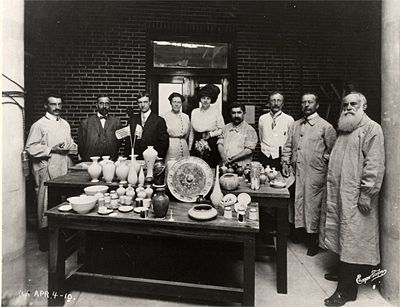
Taxile Doat
Encyclopedia
Taxile Doat was a French potter who is primarily known for his experimentation with high-fired porcelain (grand feu) and stoneware using the pâte-sur-pâte
technique. His book on these techniques Grand Feu Ceramics was published in 1905 and helped spread his discoveries internationally. His influence is apparent in the types of glazes and approaches used in studio pottery
in the twentieth century.
Doat worked at the Manufacture nationale de Sèvres
from 1877 to 1905, and was one of the artists who introduced the Art Nouveau
style. Starting in 1895, Doat began working in a house at 47 rue Brancas in the village of Sèvres
. These studio ceramics were different from the pieces he produced at the Sèvres factory. He replaced the typical classical subjects: garlands, gods, and drapery with new forms derived from the Japonisme that influenced French art pottery in the 1890s. He also began producing organic forms based on gourds, and employing new, grand feu glazes he invented.
 In 1909, Doat was one of the three international leaders of ceramics hired as a professor, along with Frederick Hurten Rhead
In 1909, Doat was one of the three international leaders of ceramics hired as a professor, along with Frederick Hurten Rhead
and Adelaïde Alsop Robineau
, at the Art Academy and Porcelain Works, founded in a St. Louis suburb, University City
. The founder of University City, Edward Gardner Lewis
, went bankrupt in 1911, and was no longer able to support the pottery studio. Doat was able to continue pottery production during 1912-14.
Pâte-sur-pâte
Pâte-sur-pâte is a method of porcelain decoration in which a relief design is created on an unfired, unglazed body by applying successive layers of white slip with a brush...
technique. His book on these techniques Grand Feu Ceramics was published in 1905 and helped spread his discoveries internationally. His influence is apparent in the types of glazes and approaches used in studio pottery
Studio pottery
Studio pottery is made by modern artists working alone or in small groups, producing unique items of pottery in small quantities, typically with all stages of manufacture carried out by one individual. Much studio pottery is tableware or cookware but an increasing number of studio potters produce...
in the twentieth century.
Doat worked at the Manufacture nationale de Sèvres
Manufacture nationale de Sèvres
The manufacture nationale de Sèvres is a Frit porcelain porcelain tendre factory at Sèvres, France. Formerly a royal, then an imperial factory, the facility is now run by the Ministry of Culture.-Brief history:...
from 1877 to 1905, and was one of the artists who introduced the Art Nouveau
Art Nouveau
Art Nouveau is an international philosophy and style of art, architecture and applied art—especially the decorative arts—that were most popular during 1890–1910. The name "Art Nouveau" is French for "new art"...
style. Starting in 1895, Doat began working in a house at 47 rue Brancas in the village of Sèvres
Sèvres
Sèvres is a commune in the southwestern suburbs of Paris, France. It is located from the centre of Paris.The town is known for its porcelain manufacture, the Manufacture nationale de Sèvres, making the famous Sèvres porcelain, as well as being the location of the International Bureau of Weights...
. These studio ceramics were different from the pieces he produced at the Sèvres factory. He replaced the typical classical subjects: garlands, gods, and drapery with new forms derived from the Japonisme that influenced French art pottery in the 1890s. He also began producing organic forms based on gourds, and employing new, grand feu glazes he invented.

Frederick Hurten Rhead
Frederick Hurten Rhead was a native of England who worked as a potter in the United States for most of his career. In addition to teaching pottery techniques, Rhead was highly influential in both studio and commercial pottery...
and Adelaïde Alsop Robineau
Adelaide Alsop Robineau
Adelaïde Alsop Robineau was an American painter, potter and ceramist.As a young woman Adelaïde became interested in the popular pursuit of china painting. She married Samuel E. Robineau of France in 1899, and in that year the couple launched Keramic Studio, a pioneering periodical for ceramic...
, at the Art Academy and Porcelain Works, founded in a St. Louis suburb, University City
University City, Missouri
University City is an inner-ring suburb in St. Louis County, Missouri. The population was 35,371 in 2010 census. The city was shaped by Washington University in St. Louis, whose campus abuts the city to the southeast....
. The founder of University City, Edward Gardner Lewis
Edward Gardner Lewis
Edward Gardner Lewis was a flamboyant and controversial promoter, magazine publisher, political activist, and founder of two utopian colonies -- University City, Missouri, and Atascadero, California....
, went bankrupt in 1911, and was no longer able to support the pottery studio. Doat was able to continue pottery production during 1912-14.

